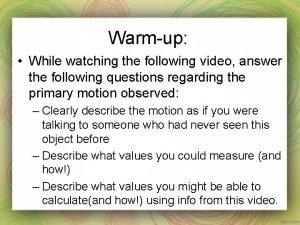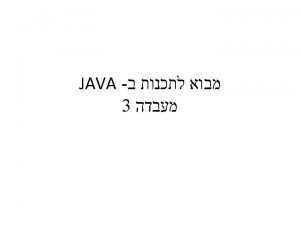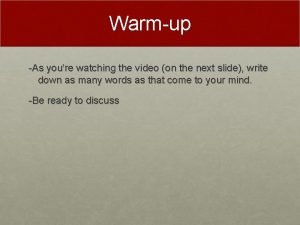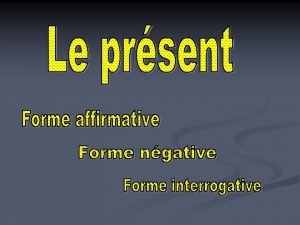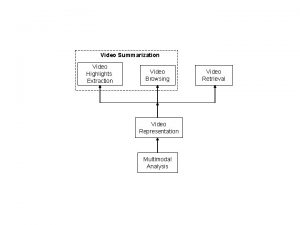Warmup While watching the following video answer the



















- Slides: 19

Warm-up: • While watching the following video, answer the following questions regarding the primary motion observed: – Clearly describe the motion as if you were talking to someone who had never seen this object before – Describe what values you could measure (and how!) – Describe what values you might be able to calculate(and how!) using info from this video.

Journal Entry: video information • This video is just about 8 minutes long, but we won’t watch the whole piece. You will have until the video is stopped to answer each part of the question from the previous slide. Use the time given • Watch: https: //www. youtube. com/watch? v=Av. Ng 2 t. G 8 c. X 8

Break it down! • On your group’s whiteboard, make 2 columns and record your answers for the 2 nd and 3 rd questions: – What can be measured (and how)? – What could be calculated (and how)? • You have 3 minutes to complete your columns and discuss with your group.

Rotational Mechanics Kinematics…but going in circles! IB Book: pp. 549 - 551

Video demo 1: Rotating Disc • Watch, Turn, and Talk: – When the disk is spinning, what keeps the erasers in place? – Which eraser do you think will slide off first as the disk speeds up from rest? – Which DID fly off first? Why?

Video demo 2 • Watch, turn, and talk: – What is the difference between angular velocity and tangential velocity? – How would we describe the direction for each velocity?

• What are the definition, the units, and the symbol for each of the following: • Angular velocity • (w): the rate of change of angular position. Typically measured in rad·s-1 • Tangential velocity (speed): • the speed of a single point on a rotating object, perpendicular to the radial direction. • How do you determine tangential velocity? • How do you determine angular velocity? • What is the mathematical relationship between these velocities?

Angular Velocity and Tangential Speed •

Angular Acceleration •

Rotational Kinematics •

Practice Problem #1 • A CD uniformly accelerates from rest to its operating speed of 500. 0 rpm in 3. 50 s. What is its angular acceleration during this time? • What is its angular acceleration if it comes uniformly to a stop in 4. 50 s?

Practice Problem #2 • A microwave oven has a 30. 0 cm diameter rotating plate for even cooking. The plate accelerates from rest at a uniform rate of 0. 87 rad·s-2 for 0. 50 s before reaching its operational speed. – How many revolutions does the plate make before reaching its operational speed? – What is the operational speed of the rotating plate?

Practice Problem #3 • The blades of a fan running at low speed turn at 210 rpm. When the fan is switched to high speed, the rotation rate increases uniformly to 380 rpm in 5. 09 s. • (a) What is the magnitude of the angular acceleration of the blades? (b) How many revolutions do the blades go through while the fan is accelerating?

Question 8. 3 a Angular Displacement I An object at rest begins to rotate with a constant angular acceleration. If this object rotates through an angle q in the time t, through what angle did it rotate in the time ½ t? a) ½ q b) ¼ q c) ¾ q d) 2 q

Question 8. 3 a Angular Displacement I An object at rest begins to rotate with a constant angular acceleration. If this object rotates through an angle q in the time t, through what angle did it rotate in the time ½ t? The angular displacement is q = a) ½ q b) ¼ q c) ¾ q d) 2 q at 2 (starting from rest), and there is a quadratic dependence on time. Therefore, in half the time, time the object has rotated through one-quarter the angle

Question 8. 3 b Angular Displacement II An object at rest begins to rotate with a constant angular acceleration. If this object has angular velocity w at time t, what was its angular velocity at the time ½ t? a) ½ w b) ¼ w c) 2 w d) 4 w

Question 8. 3 b Angular Displacement II An object at rest begins to rotate with a constant angular acceleration. If this object has angular velocity w at time t, what was its angular velocity at the time ½ t? a) ½ w b) ¼ w c) 2 w d) 4 w The angular velocity is w = at (starting from rest), and there is a linear dependence on time. Therefore, in half the time, time the object has accelerated up to only half the speed

Practice Problem #4 • A merry go-round makes 18 revolutions in a 3. 0 min ride. (a)What is its average angular velocity? (b)What are the tangential speeds of two people 4. 0 m and 5. 0 m from the center?

Homework Heads’ Up: • WA: Angular Mechanics (kinematics) is up and due Friday at 8 AM. • Please show your work for all parts for 2 of the 3 questions
 Angular acceleration symbol
Angular acceleration symbol Watching lecture than watching at at
Watching lecture than watching at at Warmup ratio
Warmup ratio Warmup 65
Warmup 65 Gmass warmup
Gmass warmup Stratified warmup
Stratified warmup Surface area warm up
Surface area warm up Identical rhyme examples
Identical rhyme examples Multiplication properties of exponents
Multiplication properties of exponents Java warmup
Java warmup Define:warmup
Define:warmup Persuasive essay quotes
Persuasive essay quotes Tinman running calculator
Tinman running calculator Warmup 65
Warmup 65 Warmup end
Warmup end Watch the video and answer the questions.
Watch the video and answer the questions. Perbedaan for while do while
Perbedaan for while do while Yandex ru video search text video
Yandex ru video search text video Yahoo gravity
Yahoo gravity Tw.search.yahoo.com
Tw.search.yahoo.com
